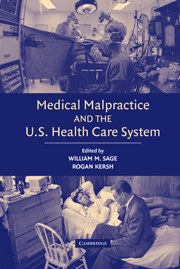Book contents
- Frontmatter
- Contents
- List of Contributors
- Introduction
- PART ONE FRAMING MEDICAL MALPRACTICE AS A HEALTH POLICY ISSUE
- PART TWO THE HEALTH POLICY IMPACT OF MEDICAL MALPRACTICE
- PART THREE MALPRACTICE REFORMS THAT SOLVE THE RIGHT PROBLEMS
- PART FOUR IN SEARCH OF A “NEW PARADIGM”
- 12 Enterprise Liability in the Twenty-First Century
- 13 Private Contractual Alternatives to Malpractice Liability
- 14 Medical Malpractice Insurance Reform: “Enterprise Insurance” and Some Alternatives
- 15 Governments as Insurers in Professional and Hospital Liability Insurance Markets
- 16 Medicare-Led Malpractice Reform
- Bibliography
- Index
16 - Medicare-Led Malpractice Reform
Published online by Cambridge University Press: 10 December 2009
- Frontmatter
- Contents
- List of Contributors
- Introduction
- PART ONE FRAMING MEDICAL MALPRACTICE AS A HEALTH POLICY ISSUE
- PART TWO THE HEALTH POLICY IMPACT OF MEDICAL MALPRACTICE
- PART THREE MALPRACTICE REFORMS THAT SOLVE THE RIGHT PROBLEMS
- PART FOUR IN SEARCH OF A “NEW PARADIGM”
- 12 Enterprise Liability in the Twenty-First Century
- 13 Private Contractual Alternatives to Malpractice Liability
- 14 Medical Malpractice Insurance Reform: “Enterprise Insurance” and Some Alternatives
- 15 Governments as Insurers in Professional and Hospital Liability Insurance Markets
- 16 Medicare-Led Malpractice Reform
- Bibliography
- Index
Summary
There is increasing interest among policy makers in an integrated approach to patient safety and medical liability. This chapter proposes and develops a breakthrough medical malpractice reform: a system of medical error identification, patient notification, rapid compensation, and safety improvement within the Medicare program. The reform would provide Medicare beneficiaries with better safety, improved communication in event of error, preservation of therapeutic relationships, timely settlement, and fair compensation at lower administrative cost. Disputes in the reformed system would be adjudicated by Medicare's existing administrative appeals system, which would work together with Medicare's quality improvement regulation and payment policy to reduce errors and compensate injured patients. Testing reform within Medicare would also make it possible to extend future reforms to the Medicaid population, which is also less likely than younger, nonindigent patients to bring malpractice claims.
WHY MEDICARE-LED MALPRACTICEREFORM?
Medical malpractice policy has been in suspended animation for decades. Nonacademic proponents of reform have hardly budged in their recommendations since 1975, and opponents by and large have countered those proposals without offering promising alternatives. The principal cause of stagnation is that medical malpractice policy has never integrated with overall health policy. In particular, the Medicare and Medicaid programs – which have shaped health policy and molded health politics since the 1960s – have never been engaged in malpractice reform.
MEDICARE CAN RECONNECT MALPRACTICE POLICY TO HEALTH POLICY
Because malpractice has not been connected to health policy, the politics of medical liability has been co-opted by the politics of general (nonmedical) tort reform.
- Type
- Chapter
- Information
- Medical Malpractice and the U.S. Health Care System , pp. 318 - 350Publisher: Cambridge University PressPrint publication year: 2006

